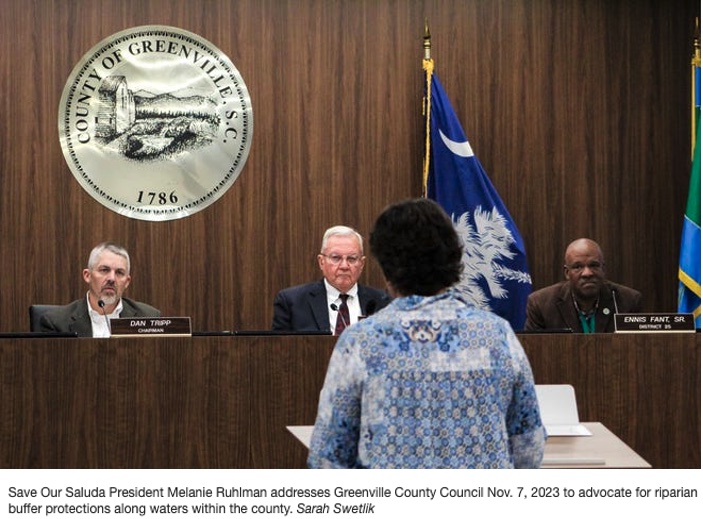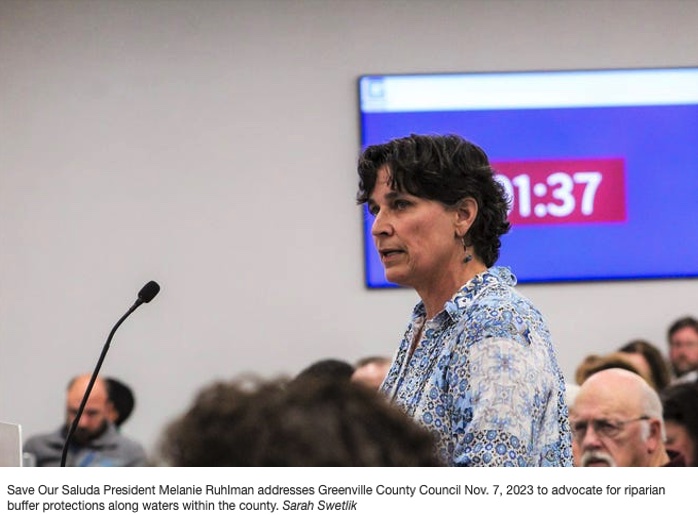Greenville County takes steps to protect natural resources amid development concerns
Greenville News

As Upstate communities continue to work to accommodate record growth, Greenville County Council on Tuesday voted favorably on a second reading of an ordinance that would require environmental protections and development limits in the county.
The ordinance will require a protected land area called a riparian buffer along streams and water bodies throughout the county. Greenville County’s riparian buffers will be a minimum of 50 feet from the edge of the water inland and will establish separation between water and the land nearby to protect both water quality and stream banks.
The ordinance also will restrict new subdivision developments in unzoned areas to meet a minimum lot size of one and a half acres to install a septic system.
The ordinance, which passed 9-3 with an amendment from Chairman Dan Tripp, is expected to receive a third and final reading Dec. 7. Councilman Ennis Fant said during Tuesday’s meeting that council members have been working on the ordinance for about nine months with extensive debate since its creation.
Various council members, members of environmental groups and developers suggested dividing the two topics from one ordinance. Most were in favor of riparian buffer protections, but others were divided on how to proceed with septic system regulations.
Residents in support of riparian buffers creation attended Tuesday’s meeting wearing blue and spoke in favor of the section of the ordinance.
Riparian buffers could protect water quality and stream banks
A riparian buffer is a strip of vegetation, like grasses, shrubs, trees or other plants, that protects a body of water from the impact of adjacent land use. If the ordinance passes the third reading, a minimum 50-foot buffer area will be required along Greenville County’s streams and jurisdictional waters, while a 100-foot buffer area will be required in areas with a higher volume of drainage.
The implementation of buffer protections in the Upstate is an effort multiple environmental groups, including Save Our Saluda, have worked on for years.
“Benefits of riparian buffers are many. They can help to filter sediment runoff and other pollutant runoff from getting into the river,” said Melanie Ruhlman, president of Save Our Saluda. “They, very importantly, hold land together and keep streambanks, riverbanks from eroding and falling away into the stream and to downstream reservoirs and drinking water sources.”
Ruhlman said she’s been working on riparian protections in Greenville since 2018, though efforts began before she was involved. The push for riparian buffers came from the Reedy River Water Quality Group, which is comprised of local, national and federal partners that work to improve the water quality of the Reedy River.
Establishing protective buffers is more cost-effective than trying to fix a damaged stream bank, Ruhlman said. Some projects require more than $100,000 to fix a small area of a stream, she said.
“The cost can range anywhere from $250 a linear foot per side up to $1,000 or more per linear foot,” she said.
Stream damage can lead to banks eroding and sediment falling into the water.
The Reedy River Water Quality Group’s push for buffers comes as part of a provision in the Clean Water Act. The Act allows local stakeholders to address pollutants in their water bodies rather than following a government-regulated plan to remove pollutants.
In addition to alleviating pressure on streambanks, buffers can also help filter excess nutrients like nitrate and phosphorus, pesticides and waste and prevent them from entering the waterway.

Limited septic systems could curb unchecked development
Under the ordinance, new developments built in unzoned areas of Greenville County with more than 10 lots served by a septic tank must have a minimum lot size of one and a half acres.
This portion of the ordinance was driven by the county, rather than environmental groups, and faced pushback from developers.
In a workshop on Oct. 2, Greenville County Department of Community Planning and Development Planning Director Rashida Jeffers-Campbell said the county is struggling to allocate land appropriately as the population continues to grow. She said the way the county currently distributes land makes it difficult to plan for transportation, sewers and schools.
“Current development trends are characterized by inefficient land consumption, and we all know that land is a finite resource,” Jeffers-Campbell said.
In efforts to combat additional pollution and slow development sprawl, Jeffers-Campbell said the ordinance aims to place limits on the use of septic systems in areas without current zoning laws. The ordinance will redirect developers toward areas where infrastructure already exists.
Jeffers-Campbell said the purpose of the ordinance is to limit the use of septic systems and limit high-density developments in areas where infrastructure can’t be easily expanded.
Despite requests from developers to make the minimum lot size smaller, Greenville County decided to move forward with the one-and-a-half-acre minimum lot size. In a planning meeting on Oct. 24, Jeffers-Campbell said making the minimum lot size any smaller would take away the incentive for developers to focus growth in areas with existing infrastructure.
How can a septic system impact the environment?
County officials voiced concern that many septic systems in high-density areas could impact development down the road, but septic systems that aren’t working properly can also pose environmental and health concerns.
Failing septic systems can expose residents to nutrients such as phosphorus and nitrogen. When they’re close to a water body, they can also contaminate surface water, according to the Environmental Protection Agency.
For most people, septic systems aren’t top of mind until they stop working, said Erika Hollis, clean water director at Upstate Forever.
While Upstate Forever was not involved in the septic portion of the ordinance, they work with the South Carolina Department of Health and Environmental Control to assist homeowners with fixing septic systems in Upstate counties. In a decade, Hollis said Upstate Forever’s grants have assisted more than 130 homeowners with septic tank repair.
In homes with septic systems, wastewater drains into an underground tank, where it is held as the water separates from solid matter, which sinks to the bottom, from oil and grease, which float to the top. The water then leaves the tank and travels to a section of soil called a drain field, according to the Environmental Protection Agency.
“Once it's not working, it's definitely like a crisis situation if you can't flush your toilet, you can't take a shower, you can't do your laundry or do your dishes,” Hollis said, adding that homeowners tend to call Upstate Forever once they’ve reached a backup. “It becomes a major quality of life issue if you can't live in a home with a functioning wastewater treatment system.”
Hollis said nine out of 10 repairs Upstate Forever handles are drain fields that aren’t working properly. Homeowners often don’t know where their drain field is, especially in older homes where septic tanks are already installed. Residents who don’t know where their drain field is located might build too close to it or park on top of it and damage it, Hollis said.
Improper use of the drain field can cause damage to the septic systems, but few records exist to help homeowners know where their drain fields are, nor are there any state laws that require inspections or dictate how often owners should get their septic tanks pumped. Fixing a damaged septic system can also be costly for the homeowner. Hollis said the average cost to fix a drainfield is currently $6,500.
Before any development or water protections can be put in place, the ordinance will have to pass a third reading. Council is set to meet next Dec. 7.
Sarah Swetlik covers climate change and environmental issues in South Carolina's Upstate for The Greenville News. Reach her at This email address is being protected from spambots. You need JavaScript enabled to view it. or on X at @sarahgswetlik.
Save Our Saluda Awarded a Second 319 Grant to Protect Water Quality in the Upper Saluda Watershed
Save our Saluda is excited to announce a second grant award from the South Carolina Department of Health and Environmental Control to protect water quality in the Upper Saluda Watershed. The $550,000 grant will allow Save Our Saluda and partnering organizations to work with local landowners and farmers within the watershed to develop and implement projects aimed at reducing soil runoff to streams and rivers upstream of Saluda Lake.
The Upper Saluda Watershed above Saluda Lake encompasses nearly 300 square miles in Greenville and Pickens Counties and provides critical water resources for local communities in the Upstate. Headwaters of the Saluda River originate at the North Carolina-South Carolina state line and flow to the South, Middle and North Saluda Rivers which ultimately drain to Saluda Lake near Easley and Greenville. Sediment is a significant problem in the lake and in the rivers and their tributaries upstream. Water quality is impaired, aquatic habitat is degraded, recreational use is diminished, and a drinking water source is impacted due to excess sedimentation. Saluda Lake provides drinking water to more than 80,000 customers in the rapidly growing Easley area. The upper lake was dredged in 2011 and 2012 at a cost of over seven million dollars, and less than a decade later it has filled in again.
Save Our Saluda began building a partnership of stakeholder organizations in 2016 to address the problem of sediment pollution in the Upper Saludas and Saluda Lake. Since then, over twenty partner organizations cooperated to develop and implement watershed plans to reduce sediment runoff. Partners provide technical assistance and matching funding for 319 grants that enable implementation of projects in priority watershed areas.
The Upper Saluda Watershed Implementation Project for Sediment will provide up to 90% cost share assistance to landowners within the watershed for soil conservation projects to protect and improve water quality. The project has the potential to reduce sediment runoff to surface waters by an estimated 524 tons per year. Participation is voluntary and based on eligibility.
Projects completed in the Upper Saluda Watershed to date include cover crops, floodplain and riparian restoration, farm road stabilization, stream restoration, sediment basin construction, and drainage improvement and stabilization. Farm equipment (a roller-crimper and no-till seed drill) was also purchased through the first 319 grant and is available for lease to area farmers to help facilitate regenerative farming practices.
Funding for this cooperative project was provided in part by the South Carolina Department of Health and Environmental Control with funds from the United States Environmental Protection Agency under Section 319 of the Clean Water Act and through additional support from Easley Combined Utilities, Trees Upstate, Duke Energy, Renewable Water Resources, MetroConnects, the Greenville Soil and Water Conservation District, and Greenville County.
Additional information about the Upper Saluda Watershed Implementation Project for Sediment is available at saveoursaluda.org/projects/ag-implementation-grant.

An interactive watershed map with an address search can be found at saveoursaluda.org/webmap.

Confluence of the North and South Saluda Rivers.
Trying to follow the many proposals by MetroConnects for sewer service expansion in Greenville County has been a moving target.
Their initial proposal was to extend sewer service County-wide, opening the door for unlimited sprawl growth:

Revision 2 included extensive rural and unzoned areas in the northern and southern areas of the County.
Revision 3 still includes substantial unzoned areas around Travelers Rest and will drive growth north into sensitive Foothills areas.

We are asking Council for an amendment to scale back Metro's sewer service areas away from sensitive areas near the rivers. Specifically, we are asking them to:
Please support an amendment to reduce the Metro boundary expansion west of Travelers Rest to protect the priority conservation area between the North Saluda River and Saluda River and Keeler Mill Road, as shown on the maps below.
This area has been a focal point for conservation over the past six years through significant state and local investments from the South Carolina Conservation Bank, Easley Combined Utilities, and more recently the Greenville County Historic and Natural Resources Trust due to expansive mature forests that occur along steep slopes, rivers and feeder streams, wetlands, and floodplains.
The South Carolina Office of Resilience, through the 2023 Resilience Plan and in cooperation with the South Carolina Forestry Commission, the Green Infrastructure Center, and the Southern Region of the USDA Forest Service, have all identified this same area along the Saludas west of TR as a priority area for conservation and green infrastructure.
The value in protecting such sensitive lands is in maintaining their function as nature-based solutions for resiliency against future extreme weather events and flooding and the threat that higher density development poses to these valuable natural resources and their native habitats, downstream water quality, and the public drinking water source at Saluda Lake, which already suffers from excess sedimentation.
Authorization of sewer service into these critical lands undermines the investments and work of local, state, and federal agencies, utilities, and conservation organizations and invites high density growth into more sensitive watershed areas. It also makes potential future conservation in this priority area much more challenging and costly to local and state funders.
Unfortunately, the newest Metro proposal includes this same priority conservation area for sewer service expansion.
Hurricane Helene taught us the danger of building around streams, rivers, and floodplains and in steeper terrain. The proposed amendment would be a proactive step to avoid that kind of catastrophe while still allowing room for responsible growth.


.jpg)
Photo courtesy of Michael Sheehan

































